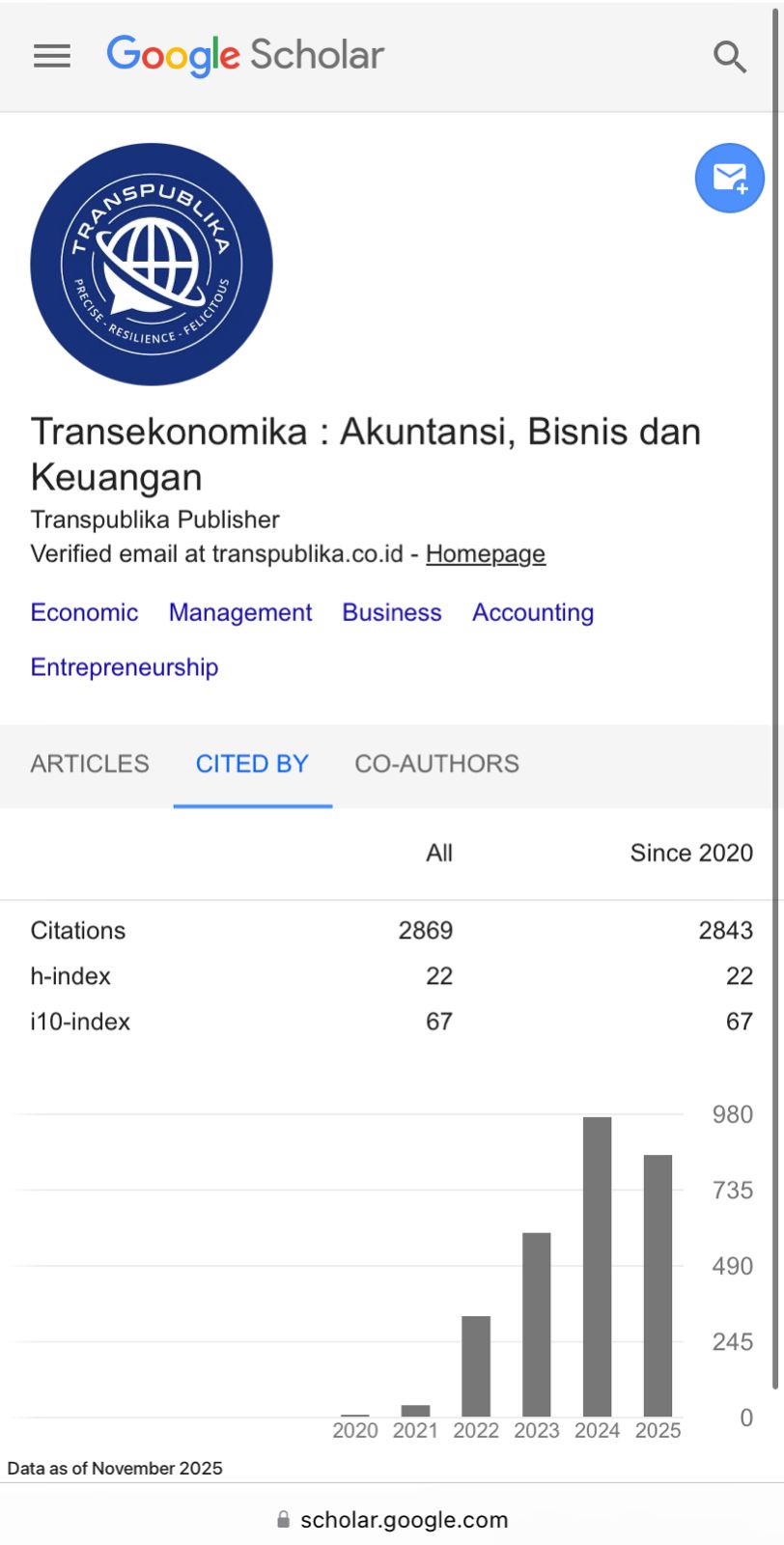ANALISIS PENGARUH VARIABEL MONETER TERHADAP PERTUMBUHAN EKONOMI DI INDONESIA
Abstract
The purpose of the analysis in this study is to determine the effect of the relationship between inflation, foreign exchange rates, and the money supply (M1) on economic growth in Indonesia. The model used is ARDL-ECM (Autoregressive Distributed Lag-Error Correction Modelm with time series data as many as 30 objects studied, starting from 1991 to 2020. In the use of data from the World Bank, one data from the Indonesian Ministry of Trade, and other sources. This study concludes that the inflation variable in the long term has a positive effect and is related to economic growth. The exchange rate variable gives the result that in the long term and short term it has a negative effect and is not related to economic growth. Finally, the M1 variable in the long-term model produces a positive influence and is related to economic growth, then in the short term it has a negative influence and is not related to economic growth in Indonesia.
Downloads
References
AbuDalu, A., Ahmed, E. M., Almasaied, S. W., & Elgazoli, A. I. (2021). The Real Effective Exchange Rate Impact on ASEAN-5 Economic Growth International Journal of Economics & The Real Effective Exchange Rate Impact on ASEAN-5 Economic Growth. International Journal of Economics & Management Sciences, 3(2). https://doi.org/10.4172/2162-6359.1000174
Ambarwati, A. D., Sara, I. M., & Aziz, I. S. A. (2021). Pengaruh Jumlah Uang Beredar (JUB ), BI Rate dan Inflasi Terhadap Pertumbuhan Ekonomi di Indonesia Periode 2009-2018. Warmadewa Economic Development Journal, 4(1), 21–27.
Andriyani, D., & Nulhanuddin. (2020). Autoregressive Distributed Lag Kurs Dan Ekspor Karet Remah Terhadap Pertumbuhan Ekonomi Indonesia. Jurnal Ekonomika Regional Unimal, 3, 47–59.
Basmar, E. (2018). Analisis Pengaruh Capital Adequatio Ratio Terhadap Kinerja Perbankan Pada Masa Krisis. Nitro Institute Of Banking and Finance Makassar.
Eltis, W. (1987). Harrod–Domar growth model. The New Palgrave Dictionary of Economics, 2, 602–604.
Fahmi, I. (2016). Bank & Lembaga Keuangan Lainnya Teori dan Aplikasi (Murkhana (ed.)). Alfabeta.
Fatoni, A., Utami, K. D. S., & Atiah, I. N. (2019). Perilaku Deposan Perbankan Syarian di Indonesia: Analisis Terhadap Displaced Commercial Risk dan Market Discipline. Li Falah-Jurnal Studi Ekonomi Dan Bisnis Islam, 4(1), 212–234.
Gujarati, D. N., & Porter, D. C. (2009). Basic Econometrics (A. E. Hilbert (ed.); fifth edit). McGraw-Hill.
Indriyani, S. (2016). Analisis Pengaruh Inflasi Dan Suku Bunga Terhadap Pertumbuhan Ekonomi Di Indonesia Tahun 2005 – 2015. Jurnal Manajemen Bisnis Krisnadwipayana, 4(2). https://doi.org/10.35137/jmbk.v4i2.37
Insukindro. (1990). The Short-and Long-term Determinants of Money and Bank Credit Markets in Indonesia. University of Essex.
Natsir, M. (2012). Ekonomi Moneter Teori & Kebijakan (A. S. Latief (ed.); Cetakan 1). Penerbit Polines Semarang.
Prayitno, L., Sandjaya, H., & Llewelyn, R. (2002). Faktor-Faktor Yang Berpengaruh Terhadap Jumlah Uang Beredar di Indonesia Sebelum dan Sesudah Krisis: Sebuah Analisis Ekonometrika. Jurnal Manajemen & Kewirausahaan, 4(1), 46–55.
Rahayu, K. I., Michael, M., & Amalia, S. (2018). Pengaruh jumlah penduduk dan inflasi serta investasi swasta terhadap pertumbuhan ekonomi dan pengangguran. INOVASI, 13(1), 39–49.
Safiullah, S., Rahmatullah, P., Naqibullah, H., Ahad, Z. A., & Zmarai, M. (2021). An Empirical Study on Monetary Policy and Economic Growth: The case of Indonesia using an ARDL - ECM Approach. PSYCHOLOGY AND EDUCATION, 58(1), 5908–5922.
Siburian, R. M. Y., & Murtala. (2019). Pengaruh Jumlah Uang Beredar dan Jumlah Penduduk Terhadap Pertumbuhan Ekonomi di Indonesia. Jurnal Ekonomi Regional Unimal, 02, 88–97.
Simarmata, J. (2021). Pengantar Teknologi Informasi (R. Watrianthos (ed.)). Yayasan Kita Menulis.
Stievany, G. M., & Jalunggono, G. (2022). Analysis Of The Effect Of Inflation, Exports And Imports On Indonesia’s Economic Growth. Marginal : Journal of Management, Accounting, General Finance and International Economic Issues, 1(3), 1–14. https://doi.org/https://doi.org/10.55047/marginal.v1i3.140
Sukirno, S. (2011). Makroekonomi Teori Pengantar. PT Rajagrafindo Persada.
Wibowo, T. (2000). Kebijakan Moneter di Masa Krisis dalam Pengendalian Inflasi dan Nilai Tukar. Kementrian Keuangan.
Widarjono, A. (2007). Ekonometrika: Teori dan Aplikasi untuk Ekonomi dan Bisnis, edisi kedua. Yogyakarta: Ekonisia FE Universitas Islam Indonesia.
Widarjono, A. (2018). Ekonometrika Pengantar dan Aplikasi DIsertai Panduan Eviews (Edisi keli). UPP STIM YKPN.
Copyright (c) 2022 Emayli Rosdwiati Puspitasari, Yustirania Septiani

This work is licensed under a Creative Commons Attribution 4.0 International License.








.png)







.png)


.png)

.png)















